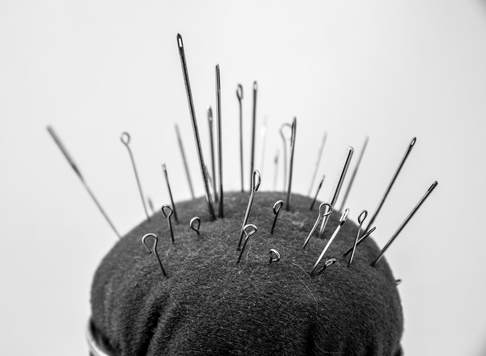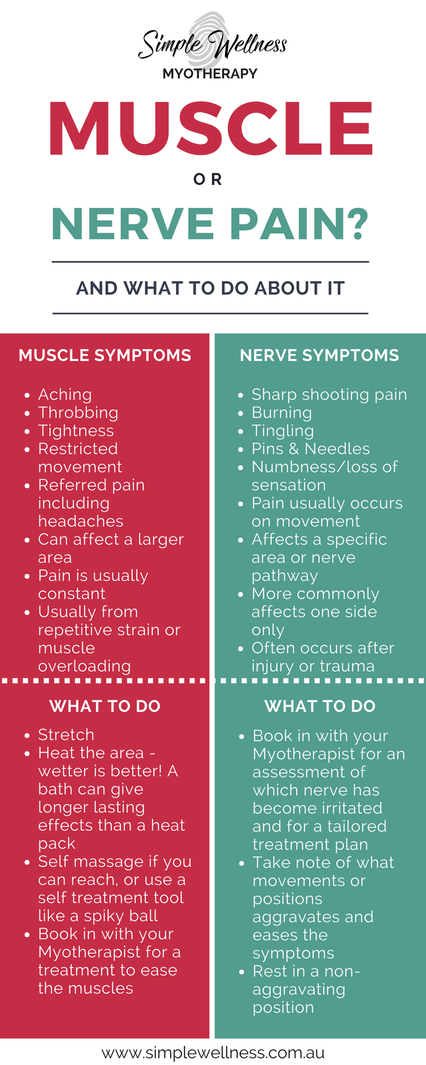Pain is sucky – no matter what it is. But sometimes it’s good to know your pain, so you know how urgently you need to act on it. One of the most common questions about pain is how can you tell if it’s muscle pain or nerve pain?
The best option is always to ask someone who can check for you – like me! But there are some ways you might be able to tell the difference.
The best option is always to ask someone who can check for you – like me! But there are some ways you might be able to tell the difference.
Muscle Pain
It’s pretty common to experience muscle pain. It might be as subtle as an ache after a workout, or it could be agony if you’ve torn a muscle. The way to recognise muscle pain is that it is generally:
Nerve Pain
Nerve pain is usually of greater concern, as your nerves hurting is a sign that something is compressing or impinging a nerve somewhere in the body. If you’re experiencing nerve pain, it is generally:
The two types of pain can exist separately, or you might experience a mix of both. But both are a sign that the body is not happy with something.
I’m In Pain Right Now. What Can I Do To Relieve It?
Pain is a signal that lets you know something might not be right and needs protection. If it’s a mild pain, there’s no need to panic. But if it’s unexpected pain, nerve pain or related to a chronic condition, your first step is to book in with your practitioner. Getting treatment right away helps to reduce your pain quicker. Your practitioner can advise you on some safe at home care practices, but if you can't get a booking at short notice there are still steps you can take.
Whether its muscle or nerve pain, the basic DIY first aid for your pain is the same. So until you are able to get it looked after, you should:
These will help to ease the pain and prevent further damage until you’re able to get in and get it checked out properly.
You’ll see that I didn’t include ice in there. There is emerging research that shows that ice may not always be the best option for treating injuries and pain. So if you want to add on some temperature relief, it’s up to you – you might feel like ice gives you some relief, or you might prefer a heat pack, or you may find best relief using an alternating combination of the two. Once I’ve assessed your pain, I will let you know which might be better for you.
The guide below is a quick way of doing the investigative work on whether your pain is muscle or nerve related, but its always best to consult with a health professional rather than trusting good old Doctor Google.
It’s pretty common to experience muscle pain. It might be as subtle as an ache after a workout, or it could be agony if you’ve torn a muscle. The way to recognise muscle pain is that it is generally:
- Over a large area – for example, your back or your lower leg
- Less defined – you can’t point to one spot that really hurts, because it’s generalised to a large area
- A sensation of aching and throbbing
Nerve Pain
Nerve pain is usually of greater concern, as your nerves hurting is a sign that something is compressing or impinging a nerve somewhere in the body. If you’re experiencing nerve pain, it is generally:
- Located over a smaller area
- A sharp, shooting sensation
- Able to cause burning or weakness in the affected area
- Pain that can cause loss of movement or function
The two types of pain can exist separately, or you might experience a mix of both. But both are a sign that the body is not happy with something.
I’m In Pain Right Now. What Can I Do To Relieve It?
Pain is a signal that lets you know something might not be right and needs protection. If it’s a mild pain, there’s no need to panic. But if it’s unexpected pain, nerve pain or related to a chronic condition, your first step is to book in with your practitioner. Getting treatment right away helps to reduce your pain quicker. Your practitioner can advise you on some safe at home care practices, but if you can't get a booking at short notice there are still steps you can take.
Whether its muscle or nerve pain, the basic DIY first aid for your pain is the same. So until you are able to get it looked after, you should:
- Rest the affected area – avoid strenuous movement and exercise
- Compress the area comfortably with a bandage if its a new injury
- Elevate the affected area if it feels swollen or inflamed. That means foot up for leg, hand up for arm
These will help to ease the pain and prevent further damage until you’re able to get in and get it checked out properly.
You’ll see that I didn’t include ice in there. There is emerging research that shows that ice may not always be the best option for treating injuries and pain. So if you want to add on some temperature relief, it’s up to you – you might feel like ice gives you some relief, or you might prefer a heat pack, or you may find best relief using an alternating combination of the two. Once I’ve assessed your pain, I will let you know which might be better for you.
The guide below is a quick way of doing the investigative work on whether your pain is muscle or nerve related, but its always best to consult with a health professional rather than trusting good old Doctor Google.
You don’t have to just grit your teeth through any sort of pain. As a qualified myotherapist, I can help to relieve your symptoms and get you back on track to health. So book in an appointment today – you won’t regret it!

